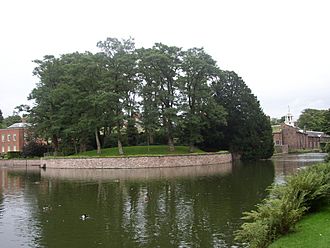Dunham Castle facts for kids
Quick facts for kids Dunham Castle |
|
|---|---|

The remaining mound at Dunham Massey Hall
|
|
| General information | |
| Architectural style | Probable motte-and-bailey castle |
| Town or city | Dunham Massey, Greater Manchester |
| Country | England |
| Coordinates | 53°22′58″N 2°23′58″W / 53.38274°N 2.399571°W |
| Client | Hamon de Massey |
Dunham Castle was an early medieval castle located in Dunham Massey, Greater Manchester, England. It was likely a simple type of castle known as a motte-and-bailey castle. These castles were common in England after the Norman Conquest.
Contents
Discovering Dunham Castle's Past
Dunham Castle is first mentioned in old records from 1173. These documents show that a powerful person named Hamo de Masci owned both Dunham Castle and another castle called Ullerwood Castle. This tells us that Dunham Castle was an important place back then.
When Was Dunham Castle Used?
Records suggest that Dunham Castle was still standing and in use in 1323. However, sometime between 1323 and 1362, the castle stopped being used. It slowly fell apart and was no longer maintained.
What Did Dunham Castle Look Like?
Historians believe Dunham Castle was built on a large mound of earth. This type of mound is called a motte. The motte at Dunham is about 24 meters (79 feet) across and still stands about 2 meters (7 feet) high today. This mound is near where Dunham Massey Hall is now.
The castle site was also surrounded by a moat. A moat is a deep, wide ditch, often filled with water, that provides protection. Over time, this moat was changed into a pretty ornamental lake.
Dunham Castle vs. Watch Hill Castle
For a while, people sometimes confused Dunham Castle with another nearby castle called Watch Hill Castle in Bowdon. However, these were two separate castles. Both castles were probably owned by the de Masci family, but they were distinct strongholds.
Protecting Historic Sites
Dunham Castle was once listed as a Scheduled Ancient Monument. This means it was recognized as an important historical site that needed special protection. However, it was later removed from this list.

